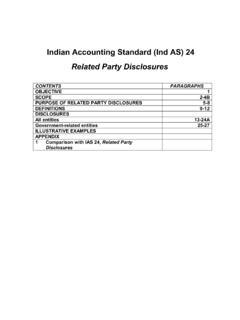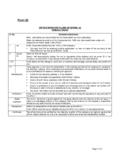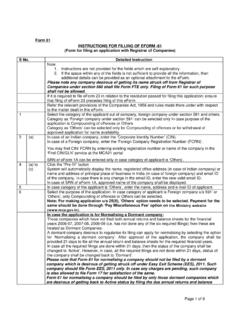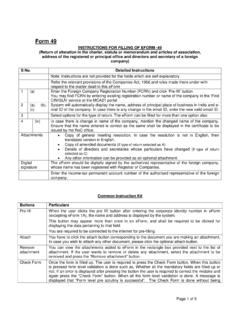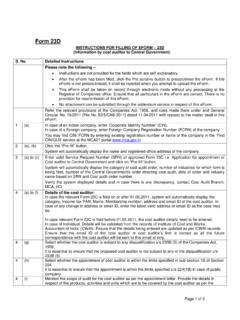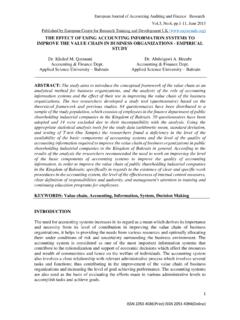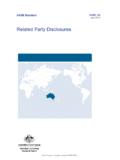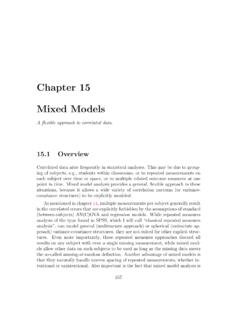Transcription of Accounting for Taxes on Income Contents
1 Accounting Standard(AS)22347 Accounting forTaxes on IncomeContentsOBJECTIVE SCOPE Paragraphs 1-3 DEFINITIONS 4-8 RECOGNITION 9-19 Re-assessment of Unrecognised Deferred Tax Assets 19 MEASUREMENT 20-26 Review of Deferred Tax Assets 26 PRESENTATION AND DISCLOSURE 27-32 TRANSITIONAL PROVISIONS 33-34 ILLUSTRATIONS 318 AS 22 (issued 2001) Accounting Standard (AS) 22 Accounting forTaxes on Income (This Accounting Standard includesparagraphsset inbolditalic typeand plain type, which have equal authority.)
2 Paragraphs in bold italic typeindicate the main principles. This Accounting Standard should be read inthe context of its objective and the General Instructions contained in part A of the Annexure to the Notification.) Objective The objective of this Standard is to prescribe Accounting treatment for Taxes onincome. Taxes on Income is one of the significant items in the statement ofprofit and loss of an enterprise. In accordance with the matchingconcept, Taxes on Income are accrued in the same period as the revenue andexpenses to which they relate. Matching of such Taxes against revenue for a periodposes special problems arising from the fact that in a number of cases, taxableincome may be significantly different from the Accounting Income . Thisdivergence between taxable Income and Accounting Income arises due totwo main reasons.
3 Firstly, there are differences between items of revenueand expenses as appearing in the statement of profit and loss and the itemswhich are considered as revenue, expenses or deductions for tax , there are differences between the amount in respect of a particularitem of revenue or expense as recognised in the statement of profit and loss andScope 1. This Standard should be applied in Accounting for Taxes on includes the determination of the amount of the expense or savingrelated to Taxes on Income in respect of an Accounting period and thedisclosure of such an amount in the financial statements. 2. For the purposes of this Standard, Taxes on Income include all domesticand foreign Taxes which are based on taxable Income . 3. This Standard does not specify when, or how, an enterprise shouldaccount for Taxes that are payable on distribution of dividends and otherdistributions made by the enterprise.
4 DefinitionsAccounting for Taxes on Income 349 4. For the purpose ofthisStandard,thefollowingterms are used withthe meanings specified: Accounting Income (loss)is the netprofitorlossforaperiod, asreported in the statement of profit and loss, before deducting incometax expense or adding Income tax Taxable Income (tax loss)istheamountofthe Income (loss) for a period, determined in accordance with the tax laws, based upon whichincome tax payable (recoverable) is determined. Tax expense (tax saving)istheaggregate ofcurrenttaxand deferredtax charged or credited to the statement of profit and loss for theperiod. Current tax is the amountofincome taxdeterminedtobepayable (recoverable) in respect of the taxable Income (tax loss) for a Deferred tax is Timing differencesarethedifferences between taxable Income and Accounting Income for a period that originate in one period and arecapable of reversal in one or more subsequent Permanent differencesarethedifferences betweentaxableincome and Accounting Income for a period that originate in one period anddo not reverse Taxable Income is calculatedin accordance with tax laws.
5 In somecircumstances, the requirements of these laws to compute taxable incomediffer from the Accounting policies applied to determine Accounting effect of this difference is that the taxable Income and Accounting incomemay not be the same. 6. The differences between taxable Income andaccounting Income can beclassified into permanent differences and timing differences. Permanentdifferences are those differences between taxable Income and accountingincome which originate in one period and do not reverse subsequently. Forinstance, if for the purpose of computing taxable Income , the tax laws allowonly a part of an item of expenditure, the disallowed amount would result ina permanent difference. 350 AS 22 7. Timing differences are those differencesbetween taxable Income andaccounting Income for a period that originate in one period and are capableof reversal in one or more subsequent periods.
6 Timing differences arisebecause the period in which some items of revenue and expenses areincluded in taxable Income do not coincide with the period in which suchitems of revenue and expenses are included or considered in arriving ataccounting Income . For example, machinery purchased for scientificresearch related to business is fully allowed as deduction in the first yearfor tax purposes whereas the same would be charged to the statement ofprofit and loss as depreciation over its useful life. The total depreciationcharged on the machinery for Accounting purposes and the amount allowedas deduction for tax purposes will ultimately be the same, but periods over which the depreciation is charged and the deduction is allowed willdiffer. Another example of timing difference is a situation where, for thepurpose of computing taxable Income , tax laws allow depreciation on thebasis of the written down value method, whereas for Accounting purposes,straight line method is used.
7 Some other examples of timing differencesarising under the Indian tax laws are given in Illustration I. 8. Unabsorbed depreciation andcarryforwardof losses which can be set-off against future taxable Income are also considered as timing differencesand result in deferred tax assets, subject to consideration of prudence (seeparagraphs 15-18). Recognition 9. Tax expense for the period, comprising current tax and deferred tax,should be included in the determination of the net profit or loss for theperiod. 10. Taxes on Income are considered to be an expense incurred by theenterprise in earning Income and are accrued in the same period as the revenueand expenses to which they relate. Such matching may result into timingdifferences. The tax effects of timing differences are included in the taxexpense in the statement of profit and loss and as deferred tax assets (subject to the consideration of prudence as set out in paragraphs 15-18) or as deferred tax liabilities, in the balance sheet.
8 11. An example of tax effect of a timing difference that results in a deferred tax asset is an expense provided in the statement of profit and loss but notallowed as a deduction under Section 43B of the Income -tax Act, 1961. This Accounting for Taxes on Income 351 timing difference will reverse when the deduction of that expense is allowed under Section 43B in subsequent year(s). An example of tax effect of atiming difference resulting in a deferred tax liability is the higher charge ofdepreciation allowable under the Income -tax Act, 1961, compared to thedepreciation provided in the statement of profit and loss. In subsequentyears, the differential will reverse when comparatively lower depreciationwill be allowed for tax purposes. 12. Permanent differences do not result in deferredtax assets ordeferredtax liabilities.
9 13. Deferred tax should be recognised for all the timing differences, subject to the consideration of prudence in respect of deferred tax assetsas set out in paragraphs :(a) The deferred tax in respect of timing differences which reverse during the tax holiday period is not recognised to the extent theenterprise s gross total Income is subject to the deduction duringthe tax holiday period as per the requirements of sections 80-IA/80-IB of the Income -tax Act, 1961 (hereinafter referred to as the Act ).In case of sections 10A/10B of the Act (covered under Chapter IIIof the Act dealing with incomes which do not form part of totalincome), the deferred tax in respect of timing differences whichreverse during the tax holiday period is not recognised to the extentdeduction from the total Income of an enterprise is allowed duringthe tax holiday period as per the provisions of the said sections.
10 (b) Deferred tax in respectoftimingdifferences which reverse afterthe tax holiday period is recognised in the year in which the timingdifferences originate. However, recognition of deferred tax assets issubject to the consideration of prudence as laid down in paragraphs15 to 18. (c) For the above purposes,the timingdifferences which originate firstare considered to reverse application of the above explanation is illustrated in theIllustration attached to the Standard. 352 AS 22 14. This Standard requires recognition of deferredtax forall the timingdifferences. This is based on the principle that the financial statements fora period should recognise the tax effect , whether current or deferred, of allthe transactions occurring in that period. 15. Except in the situations statedinparagraph 17,deferred tax assetsshould be recognised and carried forward only to the extent that there is areasonable certainty that sufficient future taxable Income will be availableagainst which such deferred tax assets can be While recognising the tax effect of timing differences, considerationof prudence cannot be ignored.
